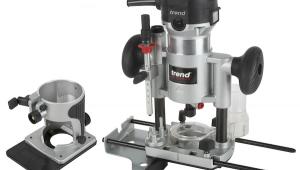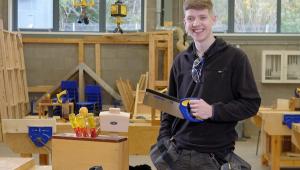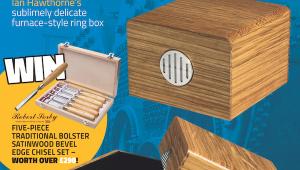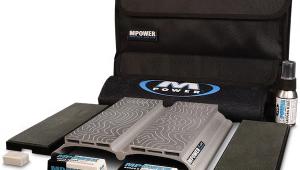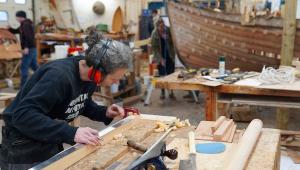Ashley Iles Mk.2 B/E Chisels
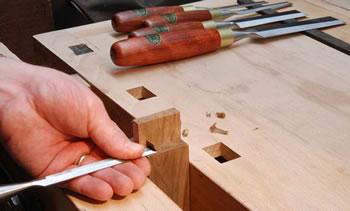
Look out for a passaround here on GetWoodworking soon to provide members an opportunity to try the tools out in their own workshops and share their thoughts and opinions.
So what have they changed?
The forged O1 oil-hardened carbon steel hardened to RC60-61 remains the same as the original chisels and their other tools, although the benefits associated with the material have been exploited slightly further. Forged carbon steel retains considerably more strength and cohesion in thin sections than air hardening steels, which means that the angles of the primary cutting bevel and the side bevels can be dramatically lower than is possible with air hardening steel. This results in a chisel that is both strong and light and also requires very little force to make it cut.
On the new chisels, the blades have been thinned even further, the sides reduced to almost nothing, and the angle of the primary cutting bevel has been reduced from 25 to 23 degrees. This slightly lower angle gives enough clearance to use secondary bevels when honing at 25 degrees for paring (cutting with the chisel parallel to the surface). For light chopping work, using gentle mallet blows with the chisel perpendicular to the surface, they recommend honing a secondary bevel at 30-35 degrees to provide more support and strength at the edge. Even with a steeper secondary bevel, the low primary bevel angle helps by reducing penetrative resistance and improves performance in the chopping role.
The HandlesMoving on to the handles, which are now considerably smaller on the 1” and below, we come to the question of balance. It is reasonably well known that a tool that has most of its weight forward of the neck is well suited for heavier work, whilst one that has the balance point further back becomes much more sensitive and accurate. The Mk.1 chisels were fitted with large handles and incorporated an extended bolster on the 2” to transfer weight backwards in an effort to give the chisels the necessary nimble, controllable feel. The large handle on the Mk. 1’s worked well for the larger sizes, but on the very small sizes the large handles transferred the centre of gravity further back than that of the user’s palm, so unless the chisel was held further back it lacked positivity.
For the Mk. 2’s they recognised that the larger handle was only really necessary for the 1-1/4, 1-1/2 and 2” sizes, and so a new handle was developed that would balance the 1” behind the neck and the 1/8” forward of the palm, maintaining a ‘nimble yet not overly light’ feel throughout the set. For those with large hands or reduced dexterity the small sizes can still be requested with the large handles.
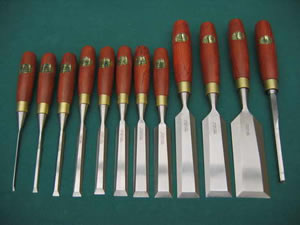
English cabinetmakers chisels should have thin, flat blades with fine edges. It is reasonably easy for a toolmaker to hit two out of three of these criteria, but hitting all three at once is tremendously difficult. A thin blade can be ground flat (not easy, but possible) however once you start grinding bevels right down to the edge the steel will invariably move and the flatness is lost. A thicker blade has the stiffness to resist this tendency but ends up being too heavy and unwieldy. Annealing would balance the internal forces in the blade that cause the movement but it would also remove the forged microstructure that gives the steel its strength in slender profiles.
After much experimentation and analysis (not to mention one promising solution that after four months of development ended up in the skip) Ashley Iles developed a new method which involves bevelling a thick blade, and then creeping up on the final dimensions using a very slow, very cool, very gentle, hand grinding technique that brings the blade down to the desired thickness without upsetting the internal structure of the steel. It is this development that has enabled them to strike the delicate balance that delivers thin blades and ‘flat’ backs and fine edges all at the same time. I am assured by AI that the new grinding method produces a surface that is substantially more accurate and more consistent than they were previously able to achieve; this area was one of the more common criticisms levelled at the Mk.1’s so it received particular attention.
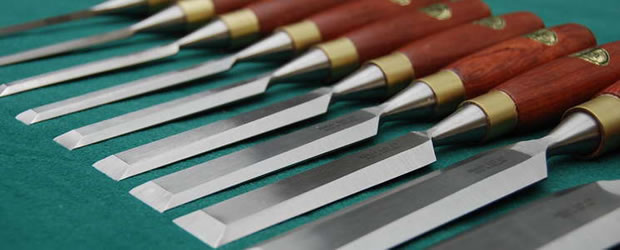
Much has been said in recent years about the importance of flat backs on chisels. Cases abound of people trying to flatten their chisels to an optically correct mirror finish all over, armed with nothing more than a 1000/6000 waterstone and grim determination, so it would seem that a little perspective is called for.
The back of a chisel functions as a registration surface, so it guides the cutting edge through the work. If the back is significantly concave then the chisel will tend to dive into the work, if it is significantly convex it will try to pull itself up out of the work. In either case, the effect is equal to the concavity or convexity over the length of the blade.
As any engineer will tell you, describing a surface as ‘flat’ without giving a tolerance is meaningless and the acceptable tolerance varies with the application. As an example, if your chisel back is hollow by 1mm over the 10cm length of the blade it will dive by 1/10th of a millimetre for every cm of the length of cut – this degree of hollowness is definitely significant and the tool should be returned. If on the other hand, the back is only hollow by 0.1mm it will dive at a rate of 1/100th of a millimetre per centimetre, which over the length of a typical chisel cut is of no significance whatsoever. Indeed, a very slight concavity in the order of 0.1mm over the length of the back can be a very helpful thing. When honing it guarantees that from the first stroke on the stone, the area that you are abrading will always extend through the cutting edge, so you can polish the important bit back up to a mirror finish with a few strokes and get back to work. A convex back has exactly the opposite effect and any effort to polish the tip will, by definition, be making the convexity steadily worse.
The sample set of Ashley Iles Mk 2 bevel edge that I have examined have all been between 0.1mm and 0.2mm of flat and could all be brought within an acceptable tolerance of 0.1mm in minutes, even if you do only have a honing waterstone or oilstone to work on. The flatness/hollowness is easily checked using a piece of float glass and a feeler gauge and I would suggest, contrary to popular rumour, that by flattening any further than 0.1mm hollow when first setting up your chisels, is actually damaging the tools and generating extra work for yourself, both in the short term and the long term. My recommendation therefore is to try using them straight from the box and see how you go with them in practice.
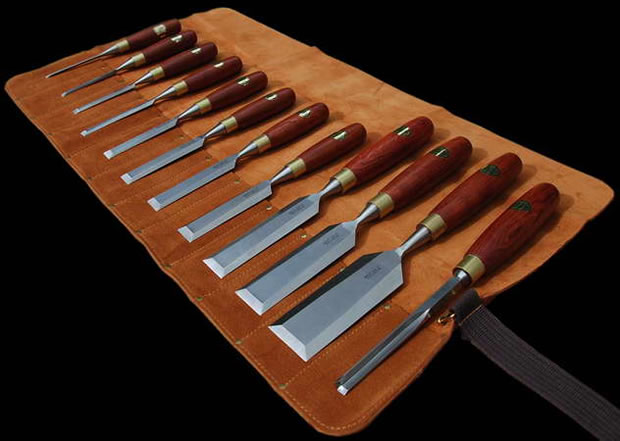
At a cost of £269.99 including VAT for a set of 12, or £119.99 including VAT for a set of 6 (including the suede tool roll) you really do get a phenomenal amount of bang for your buck. Especially when you consider that they come with an unconditional lifetime guarantee and if you are ever unlucky enough to get a really nasty ding in one you can just send it back to us, or straight to the factory with a couple of quid to cover the return postage, and get it reground free of charge.
Also available without tool rolls and individually, please click here for details.
- Log in or register to post comments
